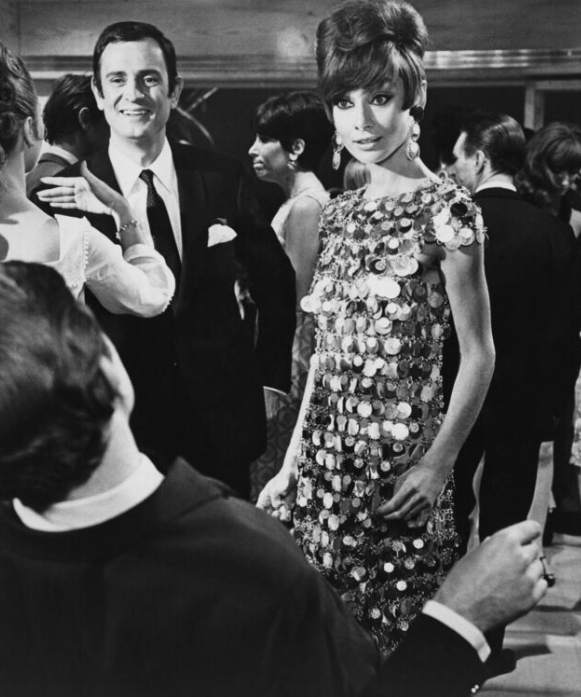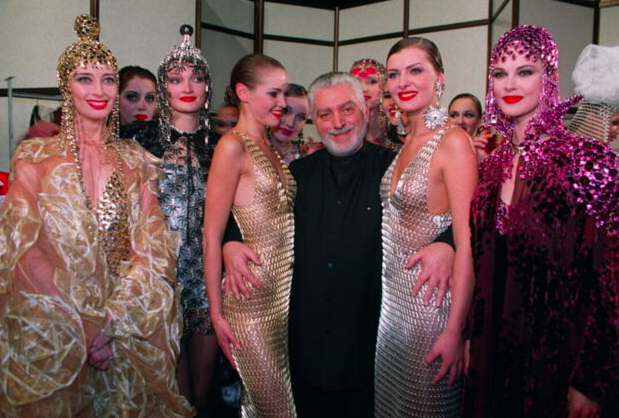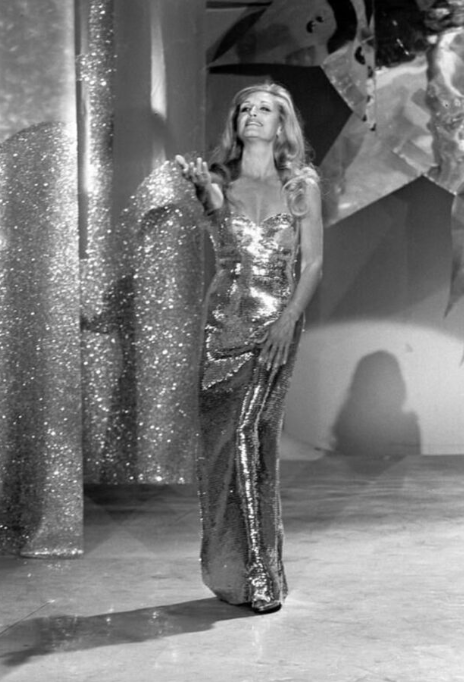
Party outfits have been popular for ages. From Yves Saint Laurent to Paco Rabanne, Studio 54 in the disco era, party outfits span the history of fashion and jewelry for as long as can be remembered. And even today, one golden rule remains: it’s gold versus silver.
In 1746, a Strasbourg jeweler named Georges Frédéric Strass decided to democratize the wearing of jewelry and in order to do so created rhinestones, made of glass crystal revealing a silvery tint. Since then, rhinestones have been attached to shoes, made into grillz, and adorned designer dresses, from the most luxurious to the most affordable.
Sequins, on the other hand, were invented in 1934, by businessman Henry Rushman who sought to rid plastic waste. Rushman’s invention became synonomous with Paco Rabanne, who created the first dress with giant sequins in 1966. A year later, Audrey Hepburn starred in Voyage à Deux, and wore a short dress by Paco Rabanne that was entirely adorned with these large metal sequins. Like the Egyptians who used glitter for their makeup, gold and silver colors quickly stood out and have never ceased to appeal to fashion more.
A symbol of luxury, celebration and splendor, these shades work on people who wear them like a mirror effect, just as much as the rhinestones and sequins with which they are tirelessly covered.

Photo: © Archive Photos/Getty Images
In 1977, the annotation “GOLD” appeared for the first time on one of Yves Saint Laurent’s sketches. In the book Gold. The golds of Yves Saint Laurent (ed. Gallimard, 2023) which accompanied the exhibition of the same title held at the Yves Saint Laurent Museum in Paris last year, historian Yvane Jacob explains, “Saint Laurent does not attach importance to the market value of gold but to the effect that gold can produce. Instead of solid gold, for his jewelry, he prefers light materials that allow him to play with volumes. For the designer, gold appears in his fashion, is omnipresent in his imagination and decorates his life.” Of course, the designer added touches of gold which marked the visual identity of the label. With Yves Saint Laurent, luxury fashion was defined by gold touches which offered a visual counterpoint to the black hue, characteristic of timeless fashion.
In a similar aesthetic strategy, Hedi Slimane covers the Couture silhouettes of the fall-winter 2023 collection with brilliant shades and ornaments. During the finales of The Wiltern in Los Angeles, Celine unveiled a swarm of gold and silver dresses, made in the house’s couture workshops in Paris and hand-embroidered with pearls, stones and sequins. Previously working at Saint Laurent, the creative director had studied in depth the attraction that gold had on the couturier, applying the shade to ever more diverse materials and patterns. From Yves Saint Lauren’s designs to the most recent collection, gold has never left luxury brands. In addition to being a recurring theme, it is also the guardian of an era, which fashion has become intersected with celebration.

Photo: © Daniel SIMON/Gamma-Rapho via Getty Images
At the turn of the 20th century, fashion evolved into a truly attractive business under the leadership of figures like Coco Chanel and Christian Dior. Khèmaïs Ben Lakhdar, fashion historian, says, “In the 1920s, many tubular embroidered dresses appeared, typical of the flapper style in force at the time, and reserved for the evening. There was no distinction or discrimination to be made between gold and silver in terms of trend because it was above all a question of promoting the idea of a general embellishment.” This embellishment which then became typical of party outfits was made possible by manufacturing techniques including embroidery – which was nevertheless for a long time reserved for the aristocratic classes. According to the historian, “In the 18th century, fabrics were certainly very expensive because they came from far away and were made by hand, but what really determined the price of a garment were the trimmings and ornaments that we added and which defined the price of the dress. This is why, initially, the decoration of clothing was reserved for the wealthiest classes, the aristocracy.”
But the 1970s saw the birth of the ready-to-wear and growth of synthetic materials, democratizing fashion and reducing the price of clothing at the time when disco was at large. “From the 70s, ready-to-wear was inspired by the festive atmosphere to create numerous silhouettes while aping the aristocracy,” adds the historian. “The development of petrochemicals will bring lurex, this golden or silver metallic fabric, into fashion, which embellishes textiles and is found in the outfits of night owls at the legendary Studio 54 in New York or even at the Palace in Paris. The disco years were the golden age of shiny clothing, again with no preference between gold and silver. At the same time, these outfits mixed chic and cheap. It could be haute couture with sublime and impeccably done embroidery, but also inexpensive clothing that sill produced a visual effect.”

Photo: © Georges DeKeerle/Sygma via Getty Images
When fashion enters the iconic “Golden Eighties”, Dalida’s stage outfits, often designed by Azzaro, tell the story of the impact of disco on the decadence of the 1980s. “All creations then included shiny materials and ornaments, silver or gold,” explains the fashion historian. Celebratory outfits are no longer reserved for the wealthy classes through the use of designers using fabrics such as lamé and lurex.

Photo: © BESTIMAGE
Even today, celebration is a theme in its own right for labels. No matter the culture, celebrations share in common in fashion that they are organized around and dominated by gold and silver. A representation of opulence common and beneficial to so many consumer sectors that the creators cannot help but comment on the parallel. Thus, many designers play on connections between golden party outfits and end-of-Christmas and New Year celebrations vial ultra-shiny silver or gold dresses made in drapes that give the the whole idea of gift wrapping, going so far as to reproduce the bow that adorns them. If, with the intelligent invention of gold and silver shades, luxury has sometimes become fake, celebration in all its forms, but in two colors, remains very real.
beauty beauty trends celebrities celebrity news christmas christmas movies coffee dating fall fashion fashion fashion designers fashion trends fashion week fitness hailey bieber hair trends halloween harry potter health Instagram Justin Bieber kate middleton King Charles meghan markle mental health milan fashion week movies music netflix new york city paris paris fashion week pregnancy prince harry princess diana prince william relationships royal family royals skincare street style television travel valentine's day wellness